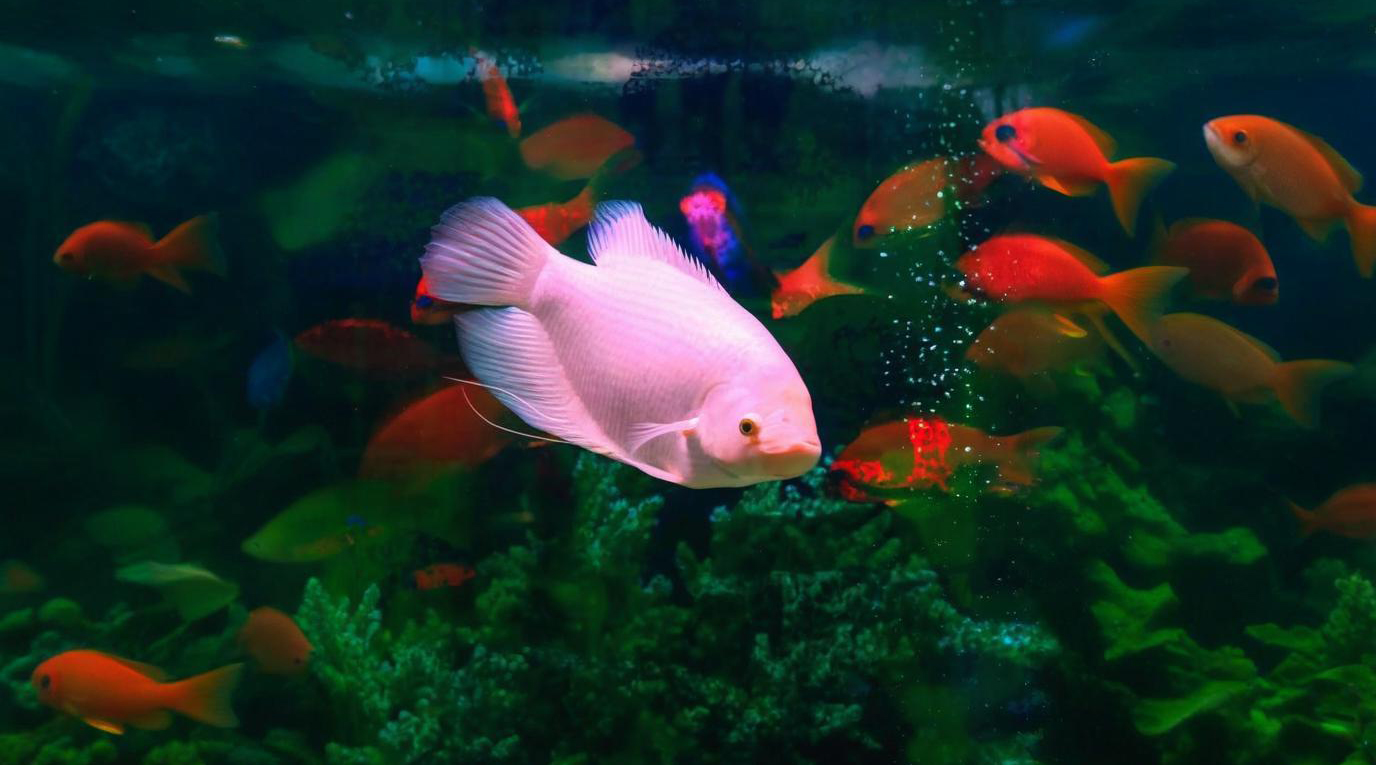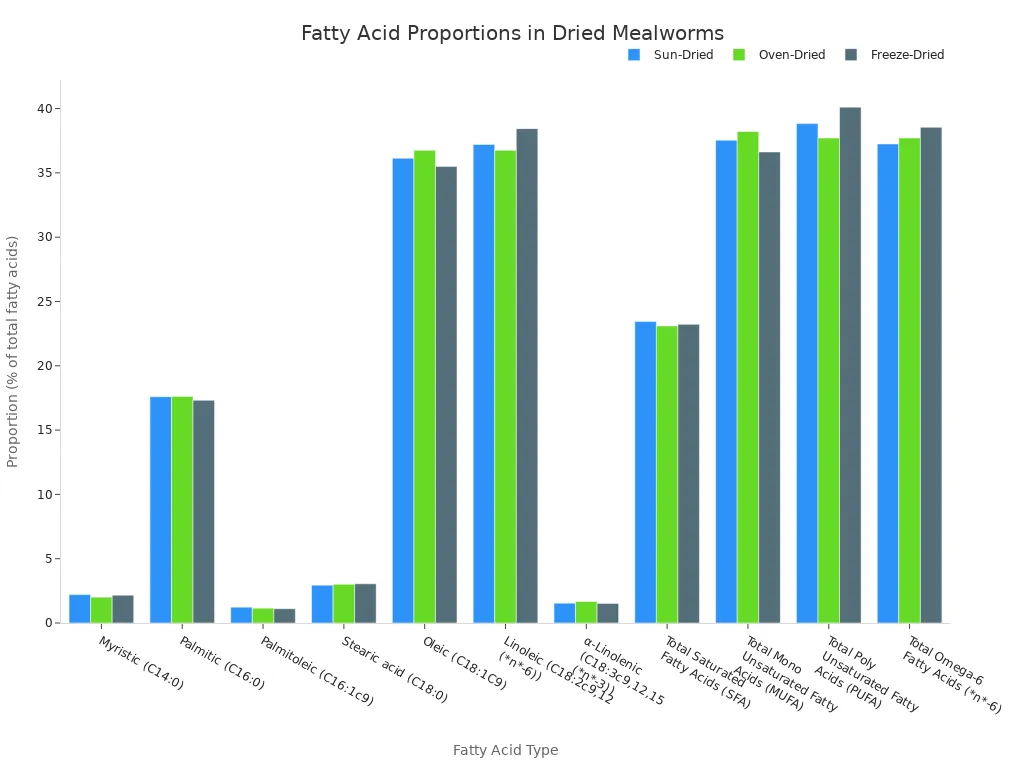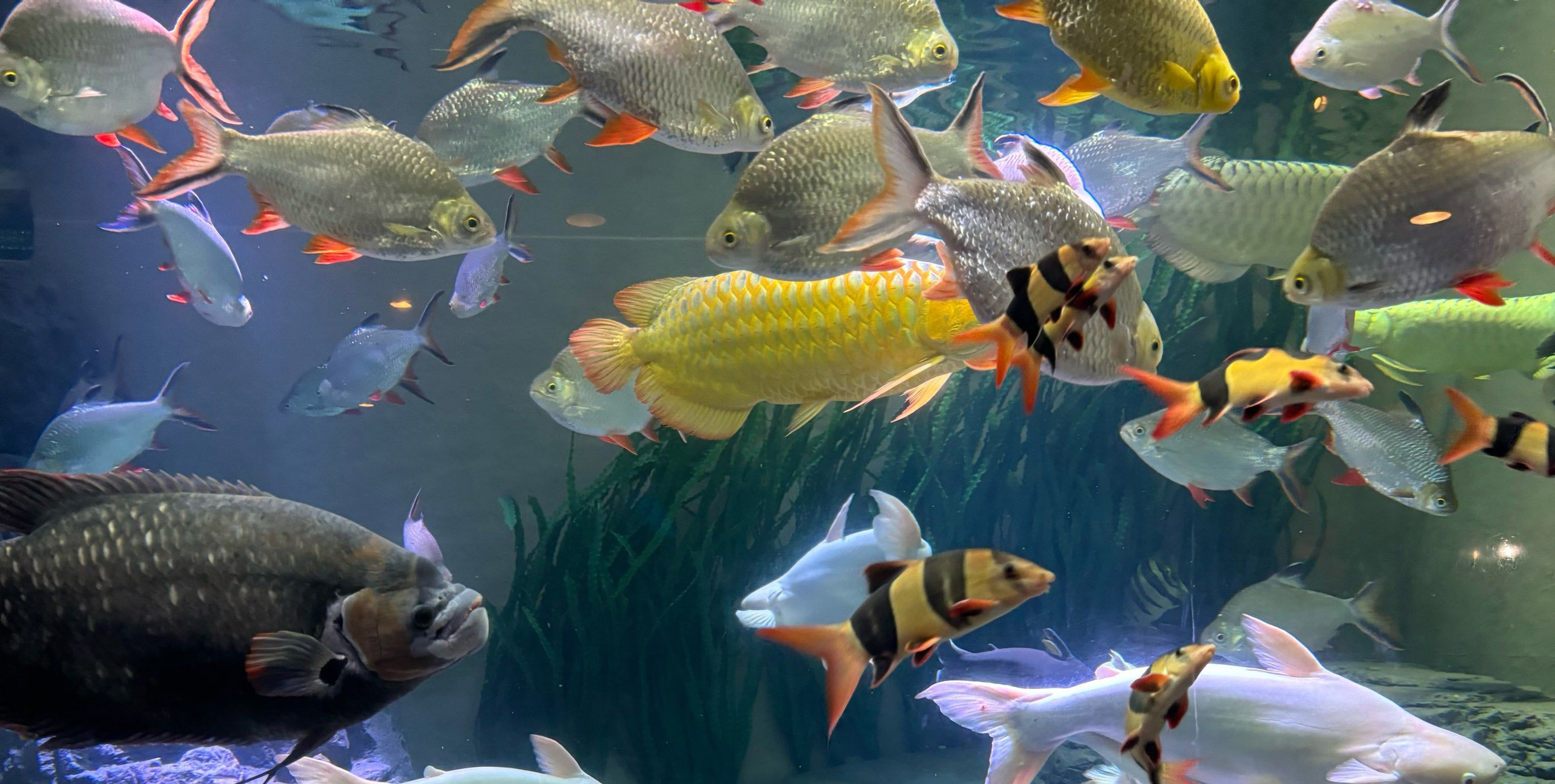
Aquaculture is a massive industry, producing 94.4 million tonnes of aquatic animals in 2022. This impressive scale demands sustainable food sources. Dried mealworms offer a compelling solution. While not a complete replacement yet, they show significant promise as an effective component of fish diets, especially with innovations from companies like Aquatic Foods Mealworms.
Key Takeaways
- Dried mealworms are a good food for fish. They have lots of protein and help fish grow strong.
- Mealworms are good for the Earth. They use less land and water than other foods. They also eat waste.
- Mealworms make fish healthier. They help fish fight off sickness. This makes them a great choice for fish farms.
The Problem with Traditional Fish Food
Over-reliance on Fishmeal
Traditional fish food often relies heavily on fishmeal. Global annual fishmeal production reaches approximately 6 million tons. Aquaculture uses a large portion of this, close to 4 million tons. This heavy reliance creates a big challenge for the industry.
Environmental Impact of Wild Catch
Catching wild fish for fishmeal production causes significant environmental problems. Overfishing depletes fish populations faster than they can reproduce. Destructive fishing methods also lead to bycatch, accidentally catching and killing non-targeted species. This harms marine biodiversity. For example, intense fishing for sardines and anchovies, used in fishmeal, negatively impacts seabirds like penguins in Cape Town. The fishing stage itself contributes about 45% of greenhouse gas emissions related to fishmeal production.
Economic Volatility and Supply Chain Issues
The fishmeal market faces many unpredictable challenges. Disruptions in wild fisheries, especially the Peruvian anchovy market, cause major supply issues. Global events, like long-term supply chain problems from past pandemics, also play a role. Climate-related impacts, such as El Niño, can cancel entire fishing seasons. These factors make fishmeal prices very unstable.
Dried Mealworms: A Promising Alternative
Nutritional Powerhouse
Mealworms are like tiny superfoods for fish. They pack a serious punch when it comes to nutrition. Imagine a snack that helps fish grow big and strong! Studies show that dried mealworms contain a whopping 51.5% crude protein on a dry matter basis. This means fish get plenty of the building blocks they need. Beyond protein, mealworms also offer essential amino acids, healthy fats, and important micronutrients. These tiny critters are a complete package, giving fish everything they need to thrive.
Sustainable Production
Raising mealworms is also incredibly kind to our planet. Think about it: traditional protein sources often demand vast stretches of land. But mealworm production is different. It uses significantly less agricultural land. For example, producing mealworm protein requires 70% less land than producing broiler protein. That’s a huge difference! Mealworms can also munch on by-products like wheat bran. This turns waste into valuable food. Plus, farmers can stack mealworm boxes vertically, like tiny insect high-rises. This vertical farming method saves even more space. If mealworms eat waste, they need almost no new land for their food. This approach makes them even more sustainable than some plant proteins.
Proven Efficacy in Aquaculture
Scientists have put mealworms to the test, and the results are exciting! Fish fed diets with mealworm meals grow just as well as fish eating traditional fishmeal. They show similar weight gain and use their food efficiently. This proves mealworms provide all the necessary nutrients for fish growth, even for hungry carnivores like Atlantic salmon. Mealworm meals also work great in Recirculating Aquaculture Systems (RAS). They do not break down easily, which helps keep the water clean. This is a big plus for water quality.
Mealworms also boost fish health. Research shows fish fed mealworm diets have higher levels of plasma IgM. This means their immune systems get stronger. They can fight off diseases better! Mealworms also contain chitin. Chitin is a special fiber that can help fish stay healthy. Companies like Aquatic Foods Mealworms are at the forefront, developing these effective and nutritious feed options. They ensure fish get a balanced diet. Mealworms are truly a promising new protein source for many fish species, from rainbow trout to tilapia.
Nutritional Profile of Dried Mealworms
Dried mealworms are like tiny treasure chests of nutrition for fish. They offer a fantastic blend of what fish need to grow big and strong. Let’s dive into their amazing nutritional profile!
High Protein Content
Fish need lots of protein to build their bodies. Mealworms deliver! They are little protein powerhouses. Different types of mealworms offer varying amounts, but they all provide a significant protein boost. Look at how much protein they contain:
| Measurement Method | Average Crude Protein (%) | Range of Crude Protein (%) |
|---|---|---|
| Standard methods (e.g., Dumas, Kjeldahl) | 52.4 | 47.0 – 60.2 |
| Corrected with kp = 5.41 | 47.2 | 43.9 – 51.0 |
This table shows mealworms are truly packed with protein. Fish get plenty of the building blocks they need from these crunchy treats.
Essential Amino Acids
Think of amino acids as tiny LEGO bricks. Fish need specific kinds of these bricks, called essential amino acids, to build their muscles and stay healthy. They cannot make these special bricks themselves. Luckily, mealworms provide all these important pieces. They offer a complete set of amino acids, ensuring fish get everything necessary for proper development and well-being.
Healthy Fats and Micronutrients
Mealworms also give fish healthy fats. These fats provide energy and help fish absorb important vitamins. They contain a wonderful mix of fatty acids. Oleic, palmitic, and linoleic acids are the main ones, no matter how you dry the mealworms. Oleic acid is usually the most abundant, making up a large portion of their fat content.

Beyond fats, mealworms also have tiny helpers called vitamins and minerals. These keep fish strong and their immune systems happy. Aquatic Foods Mealworms ensures their products deliver these vital nutrients.
- Vitamins: Dried mealworms are rich in B vitamins, specifically B12 and B2.
- Minerals: They contain essential minerals such as iron, calcium, magnesium, and zinc.
Here are some of the important minerals they offer:
| Mineral | Value |
|---|---|
| Calcium | 0.05% |
| Phosphorus | 1.03% |
| Sodium | 0.097% |
| Manganese | 23 ppm |
| Zinc | 144 ppm |
These nutrients make mealworms a fantastic addition to any fish’s diet!
Environmental Benefits of Mealworm Farming
Mealworm farming offers fantastic news for our planet. These tiny insects are not just great for fish; they also help the environment in big ways!
Reduced Land and Water Footprint
Mealworms are incredibly efficient. They do not need vast fields or huge amounts of water like traditional livestock. Farmers can stack mealworm habitats vertically, saving precious land. This means less deforestation and more space for nature. Mealworms also drink very little water, making them a smart choice for areas with water shortages. They truly are champions of resource conservation!
Waste Conversion and Circular Economy
Mealworms are nature’s little recyclers. They gobble up organic waste, turning it into valuable protein. This amazing process helps create a circular economy. Instead of throwing away food scraps, we can feed them to mealworms! These hungry critters can convert many types of organic waste into biomass. They enjoy:
- White wine pomace
- Red wine pomace
- Irish potato waste
- Okara
- Barley spent grain (BSG)
- Sesame oil meal (SOM)
- Spent coffee grounds (SCG) This clever system reduces landfill waste and gives us a sustainable protein source.
Lower Greenhouse Gas Emissions
Mealworms are environmental champions! Producing mealworm protein creates far fewer greenhouse gases than many other protein sources. Mealworm production has a Global Warming Potential (GWP) of 14 kg of CO2-equivalent per kilogram of edible protein. That is a much smaller number! A Dutch study shows mealworm protein generates about half the greenhouse gas emissions of protein from milk, pork, or chicken. It even produces about one-tenth of the emissions from beef. Choosing mealworms helps fight climate change.
Impact on Fish Growth and Health

Mealworms do more than just offer a sustainable food source; they also work wonders for fish growth and overall health. These tiny powerhouses help fish grow bigger, stronger, and more resistant to sickness. It is like giving them a super-boost!
Enhanced Growth Rates
Fish love mealworms, and mealworms love helping fish grow! Studies show that adding mealworm meal to a fish’s diet can significantly boost their growth. For example, researchers found that rainbow trout grew much better when their food included mealworm. Their weight gain and growth speed increased, especially when mealworm made up to 14% of their diet. These fish also used their food more efficiently and converted it into protein better than fish on control diets.
However, more is not always better. Scientists discovered that very high levels of mealworm in fish food can sometimes slow down growth and make it harder for fish to use their food. This happens with species like turbot, red hybrid tilapia, black porgy, and meager when mealworm levels reach around 30% or more.
| Fish Species | Mealworm Inclusion Level | Effect on Growth/Feed Utilization |
|---|---|---|
| Turbot | 30% | Reduced feed utilization and growth performance |
| Red Hybrid Tilapia | 32.5% | Reduced feed utilization and growth performance |
| Black Porgy | 33.6% | Reduced feed utilization and growth performance |
| Meager | 30% | Reduced feed utilization and growth performance |
High amounts of mealworm can sometimes cause problems. Fish might not digest it well, or the mealworms might lack certain tiny nutrients. They could even contain small amounts of natural toxins. The exact effects depend on the fish species, how long they eat the diet, their size, and other conditions.
Improved Immunity and Disease Resistance
Mealworms are like tiny bodyguards for fish, helping them fight off sickness. They contain special compounds that boost a fish’s immune system. Two important ones are chitin and tenecin-1. Chitin comes from the mealworm’s outer shell. It helps make fish stronger against diseases. Tenecin-1 also contributes to these immune-boosting effects.
Research shows amazing results for fish eating mealworm diets. A big review of many studies found that yellow mealworm meal helped European sea bass fight off bacteria and parasites. Yellow catfish also showed stronger immune responses and better disease resistance when their diet included 18% and 27% yellow mealworm. Their blood showed higher levels of important immune markers, and their bodies produced more immune-related genes. When challenged with harmful bacteria, yellow catfish fed 27% mealworm meal had a much higher survival rate.
Other studies also confirm these benefits. Replacing some fish meal with defatted mealworm improved disease resistance in red seabream. Mealworm inclusion also increases the activity of immune system enzymes in many fish species. These include European seabass, rainbow trout, mandarin fish, and pearl gentian grouper. Aquatic Foods Mealworms understands these benefits. They work to provide high-quality mealworm products that support fish health and vitality.
Palatability and Digestibility
Fish find mealworms quite tasty! Their natural appeal means fish readily accept them in their diets. This is important because even the most nutritious food does no good if fish refuse to eat it. Beyond taste, fish also digest mealworms very well. This means their bodies can easily break down the mealworm nutrients and use them for energy and growth. For example, Pacific white shrimp digest the crude protein in mealworm meal with an apparent digestibility coefficient of 76.1%. This high digestibility ensures fish get the most out of every mealworm bite.
Aquatic Foods Mealworms: Addressing the Challenges
Mealworms offer a bright future for fish food. Yet, some hurdles remain before they become a common sight in every fish tank. Companies like Aquatic Foods Mealworms actively work to overcome these challenges.
Current Production Costs
New technologies often start with higher costs. Mealworm farming is no different. Setting up large-scale mealworm farms requires significant investment. This includes specialized equipment and controlled environments. These initial costs can make mealworm-based feeds more expensive than traditional options. However, as the industry grows, production methods become more efficient. This helps bring prices down.
Scalability and Industrialization
Mealworms show great promise. However, scaling up production for industrial use faces hurdles. Current legislation could represent some restrictions. These rules in different places can limit how much mealworm production can grow. Companies also need to figure out the best ways to extract protein from mealworms. They need methods that work well on a large scale. This means finding efficient and cost-effective processes. They evaluate different extraction methods. They check if defatting the insects first makes a better product. The goal is a high-protein powder, at least 90% protein. Beyond the farm, regulatory challenges exist in many regions. Also, some markets still have limited consumer acceptance for insect-based products.
Potential Nutritional Gaps
Mealworms are fantastic. Still, they might not be a perfect, standalone food for every fish species. Researchers continue to study mealworms. They want to ensure mealworms provide all the tiny nutrients fish need. Sometimes, fish need a very specific mix of vitamins or minerals. Mealworms might need supplements to fill these gaps for certain fish. Aquatic Foods Mealworms works to create balanced diets. They ensure fish get complete nutrition.
The Road Ahead for Mealworm Diets
The journey for mealworm diets is just beginning. Scientists are working hard to find the perfect recipes for fish food. They want to know exactly how much mealworm to add. This will unlock their full potential.
Optimizing Feed Formulations
Researchers are fine-tuning the amount of mealworm to include in fish diets. They conduct studies to find the sweet spot. For example, a study looked at Atlantic salmon. They found that including 15% mealworm meal in their diet worked great. The salmon grew well. However, when they added 30% mealworm, the fish had trouble digesting protein. This shows that finding the right balance is key. Researchers need to study how different processing affects mealworm protein quality. This will help them make better recommendations for fish farmers.
Exploring Processing Methods
How we prepare mealworms also makes a big difference. Think about cooking food for yourself! Different methods change the nutrients. Researchers are exploring the best ways to process mealworms for fish. They want to keep all the good stuff inside.
| Cooking Technique | Effect on Protein Digestibility (in vitro) |
|---|---|
| Steaming | High value, less invasive |
| Uncooked (Control) | High value |
| Oven Cooking (70°C, 30 min) | Highest value |
| Deep Frying | Worst digestibility |
Steaming mealworms seems like a gentle way to prepare them. It helps keep their nutritional value high. Other methods, like deep frying, can change the fats and proteins too much. Choosing the right cooking technique is vital for making the best fish food.
Expanding Species-Specific Applications
Every fish is unique, just like people! A diet perfect for one fish might not be ideal for another. The future of mealworm diets means creating special foods for different fish species. Scientists will study what each type of fish needs. This way, they can make mealworm-based foods that help every fish thrive. From tiny aquarium fish to big farmed species, mealworms can offer tailored nutrition. This will ensure all fish get the best possible start in life.
Dried mealworms offer a compelling solution for aquaculture. They provide a sustainable and nutritious alternative. Continued research and investment are crucial for their widespread adoption. Experts project the insect feed market, including fish food, will grow by 18% each year until 2035. This means mealworms are poised to play a significant role in future sustainable fish farming.
FAQ
Can all fish eat dried mealworms? 🐠
Most fish enjoy dried mealworms as a tasty snack. Always ensure the mealworm size fits your fish’s mouth. Remove any uneaten pieces quickly to keep the tank clean.
How often should I feed my fish mealworms? 🗓️
Mealworms are a fantastic treat, not a daily meal. Offer them in moderation as part of a varied diet. This keeps your fish healthy and happy. Too many can cause problems.
Are mealworms good for the environment? 🌱
Yes, they are! Farmers raise mealworms on organic waste. This process reduces landfill waste. It also uses less land and water than traditional farming. Mealworms are a very sustainable protein source.


